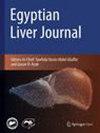Impact of treating chronic hepatitis C with direct acting antivirals on health-related quality of life: a real-life Egyptian experience
IF 0.7
Q4 GASTROENTEROLOGY & HEPATOLOGY
引用次数: 0
Abstract
Chronic hepatitis C virus (HCV) infection negatively impacts health-related quality of life (HRQL). We aimed to assess patient-reported outcomes (PROs) to evaluate the impact of treating chronic HCV with directly acting antivirals (DAAs) on HRQL. PROs were assessed prospectively using the PROQOL-HCV questionnaire before (week 0), at the end (week 12), and after DAA treatment at week 24. HRQL was measured in six different dimensions: physical health, emotional health, future uncertainty, intimate relationships, social health, and cognitive functions. A total of 500 HCV patients receiving DAAs were enrolled; of them, 399 were included in the analysis (median age 57 years, 59% females). HRQL increased significantly between baseline, end of treatment, and week 24 for all dimensions (P < 0.001), more often for physical health in females compared to males (OR = 1.69, 95% CI = 1.1–2.5), for future uncertainty among people with diabetes (1.75, 95% CI = 1.05–2.9), and for cognitive functions among obese patients (OR = 1.98; 95% CI = 1.1–3.3). Improvement in HRQL was less common for intimate relations among females (OR = 0.47; 95% CI = 0.3–0.7) and in patients with cirrhosis (OR = 0.35, 95% CI = 0.1–0.7). Improvement in HRQL was consistently higher in < 60 years compared to ≥ 60 years patients, with a significant difference in social health (P < 0.001) and future uncertainty (P < 0.049) HRQL domains. HRQL improved with DAA therapy, a relation consistent across all HRQL dimensions up to 12 weeks after the end of treatment.用直接作用抗病毒药物治疗慢性丙型肝炎对健康相关生活质量的影响:埃及的真实体验
慢性丙型肝炎病毒(HCV)感染会对健康相关生活质量(HRQL)产生负面影响。我们旨在评估患者报告的结果(PROs),以评价直接作用抗病毒药物(DAAs)治疗慢性丙型肝炎病毒对 HRQL 的影响。在DAA治疗前(第0周)、治疗结束时(第12周)和治疗后(第24周),我们使用PROQOL-HCV问卷对PROs进行了前瞻性评估。HRQL 从六个不同维度进行测量:身体健康、情绪健康、未来不确定性、亲密关系、社会健康和认知功能。共有500名接受DAAs治疗的HCV患者参与了研究,其中399人纳入了分析(中位年龄为57岁,59%为女性)。在基线、治疗结束和第 24 周之间,所有方面的 HRQL 均有明显增加(P < 0.001),女性与男性相比,在身体健康方面(OR = 1.69,95% CI = 1.1-2.5)、糖尿病患者的未来不确定性方面(1.75,95% CI = 1.05-2.9)以及肥胖患者的认知功能方面(OR = 1.98; 95% CI = 1.1-3.3),HRQL 增加的频率更高。女性(OR = 0.47; 95% CI = 0.3-0.7)和肝硬化患者(OR = 0.35, 95% CI = 0.1-0.7)在亲密关系方面的 HRQL 改善较少。与年龄≥60岁的患者相比,年龄<60岁的患者的HRQL改善程度一直较高,在社会健康(P<0.001)和未来不确定性(P<0.049)HRQL领域差异显著。DAA治疗改善了患者的HRQL,这种关系在治疗结束后12周内的所有HRQL维度上都是一致的。
本文章由计算机程序翻译,如有差异,请以英文原文为准。
求助全文
约1分钟内获得全文
求助全文

 求助内容:
求助内容: 应助结果提醒方式:
应助结果提醒方式:


